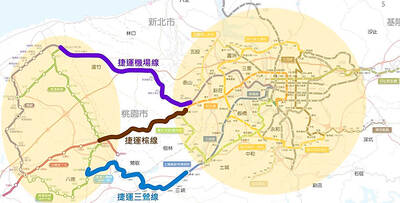Renewed talk of building a bridge to connect Kinmen Island with China’s port city of Xiamen has put the sparsely populated island county in the spotlight as it fights to promote a project that seems to have little if any support from the central government or the opposition.
Local media reported on Thursday that President Ma Ying-jeou (馬英九) had given the order to start the project, but Presidential Spokesman Wang Yu-chi (王郁琦) clarified that Ma had simply asked about the progress of a feasibility assessment on building the bridge.
A Cabinet spokesman later said there was no timetable to complete the feasibility study, a clear indication the government is in no rush to move forward on the ambitious project.
The Democratic Progressive Party opposes the idea, branding it as a step toward unification with China. Even Chinese Nationalist Party (KMT) legislators worry the bridge’s construction would divert local taxpayer funds to help China develop Xiamen.
Yet Kinmen residents want their island, a former front line against China, to be transformed into a new frontier for peace by building a road link to China.
Support for the project, called the Jindeng Bridge (金嶝大橋), is especially strong among those over 60 who experienced the month-long artillery bombardment of the island by the Chinese army in 1958 that killed more than 600 servicemen and civilians and injured more than 2,600.
Most of those now dream of “driving a car from Kinmen to Xiamen in a day,” said Yen Chung-cheng (顏忠誠), a Kinmen native who once served as a vice commander-in-chief of the Republic of China Army.
During his stint as Taiwan’s Fujian governor, a now-defunct position once responsible for Kinmen and Matsu, Yen listed the building of a bridge connecting Kinmen and Xiamen as one of the three major “projects of hope” in the region.
A public opinion poll conducted by the National Kinmen Institute of Technology in April 2007 found building a bridge to Xiamen was the issue of second-greatest concern to the county’s residents, trailing only the need for improved health and emergency care.
The 83.9 percent of respondents who felt it was an important issue believed it was necessary to cement ties with China, around which many of the lives of the 50,000 people who reside in Kinmen revolve.
Kinmen County Commissioner Lee Chu-feng (李炷烽) is firmly behind the project, saying Kinmen has served as a bridge connecting the two sides of the Taiwan Strait since direct ferry services to Xiamen and other Chinese ports were launched in early 2001.
“The building of the Jindeng Bridge will not only help hone Taiwan’s bridge building technologies, it will also help boost development in Kinmen itself,” Lee said. “The Jindeng Bridge will facilitate the building of water pipes and electricity transmission cables between Kinmen and Xiamen, allowing Kinmen to import fresh water and electricity from China — moves that would also manifest Taiwan’s sincerity in pursuing peace and co-prosperity with China.”
The Kinmen County Government said 974,000 people traveled between Kinmen and Xiamen last year, up from the 21,000 who used the ferry service in its inaugural year, an indication, it says, of the county’s crucial role as a gateway to China.
Yet that role has been threatened since direct air and sea links were opened between Taiwan and China last December, prompting Kinmen residents to seek further breakthroughs in its ties with China, particularly Xiamen, Kinmen County Council Speaker Hsieh Yi-chang (謝宜璋) said.
Lee said the Kinmen County Government began studying the possibility of building of a bridge between Kinmen and Xiamen in 2004 and has since proposed three different projects.
Plan A is a 10.3km bridge that would connect Wulongshan (五龍山) in Kinmen, to Jiaoyu (角嶼) and Xiaodeng islets (小嶝嶼) and on to Dadeng Island (大嶝島), which sits west-northwest of Xiamen Island and northeast of Kinmen.
Plan B, the Jindeng Bridge plan, would span 8.6km and directly connect Wulongshan and Dadeng Island.
Plan C is a 11.4km bridge between Wulongshan and Fujian Province’s Lianhe, which lies further north of Xiamen.
The costs of the three plans range from NT$12.7 billion (US$377.98 million) to NT$16.6 billion, Lee said.
Lee said Kinmen County prefers the second option because it is the most direct and the least costly.
If the bridge were built, it would take less than 30 minutes to drive from Kinmen to the island on which the center of Xiamen lies, by way of Dadeng, a land bridge to Xiangan north of Xiamen and then a tunnel currently under construction from Xiangan to Xiamen, Hsieh said.
A bridge would further tie the Taiwanese island to the major Chinese port city.
An increasing number of Kinmen youths have also chosen to attend schools in Xiamen rather than traveling to Taiwan proper for studies after the ferry service was opened.
Moreover, as their children went to Xiamen to get an education, parents in Kinmen began to purchase houses or invest in real estate in Xiamen.
Hsieh says the bridge would turn Kinmen into a Xiamen suburb, giving Kinmen residents more convenient links to the big city.
“A genuine one-day traffic zone between Kinmen and Xiamen would be created,” Hsieh said.

“China is preparing to invade Taiwan,” Deputy Minister of Foreign Affairs Francois Wu (吳志中) said in an exclusive interview with British media channel Sky News for a special report titled, “Is Taiwan ready for a Chinese invasion?” the Ministry of Foreign Affairs said today in a statement. The 25-minute-long special report by Helen Ann-Smith released yesterday saw Sky News travel to Penghu, Taoyuan and Taipei to discuss the possibility of a Chinese invasion and how Taiwan is preparing for an attack. The film observed emergency response drills, interviewed baseball fans at the Taipei Dome on their views of US President

ECONOMIC BENEFITS: The imports from Belize would replace those from Honduras, whose shrimp exports have dropped 67 percent since cutting ties in 2023 Maintaining ties with Taiwan has economic benefits, Ministry of Foreign Affairs officials said yesterday, citing the approval of frozen whiteleg shrimp imports from Belize by the Food and Drug Administration (FDA) as an example. The FDA on Wednesday approved the tariff-free imports from Belize after the whiteleg shrimp passed the Systematic Inspection of Imported Food, which would continue to boost mutual trade, the ministry said. Taiwan’s annual consumption of whiteleg shrimps stands at 30,000 tonnes, far exceeding domestic production, the ministry said. Taiwan used to fill the gap by importing shrimps from Honduras, but purchases slumped after Tegucigalpa severed diplomatic ties with Taiwan

The Executive Yuan yesterday approved a southwestern extension of the Sanying MRT Line from New Taipei to Bade District (八德) in Taoyuan, with a goal of starting construction by late 2026. The 4.03-kilometer extension, featuring three new stations, will run from the current terminus at Yingtao Fude Station (LB12) in New Taipei City to Dannan Station (LB14), where it will connect with Taoyuan’s Green Line, New Taipei City Metro Corp said in a statement. This extension will follow the completion of core Sanying Line, a 14.29-kilometer medium-capacity system linking Tucheng (土城), Sansia (三峽)

CARGO LOSS: About 50 containers at the stern of the ‘Ever Lunar’ cargo ship went overboard, prompting the temporary closure of the port and disrupting operations Evergreen Marine Corp, Taiwan’s largest container shipper, yesterday said that all crew members aboard the Ever Lunar (長月) were safe after dozens of containers fell overboard off the coast of Peru the previous day. The incident occurred at 9:40am on Friday as the Ever Lunar was anchored and waiting to enter the Port of Callao when it suddenly experienced severe rolling, Evergreen said in a statement. The rolling, which caused the containers to fall, might have been caused by factors including a tsunami triggered by an earthquake in Russia, poor winter sea conditions in South America or a sudden influx of waves,